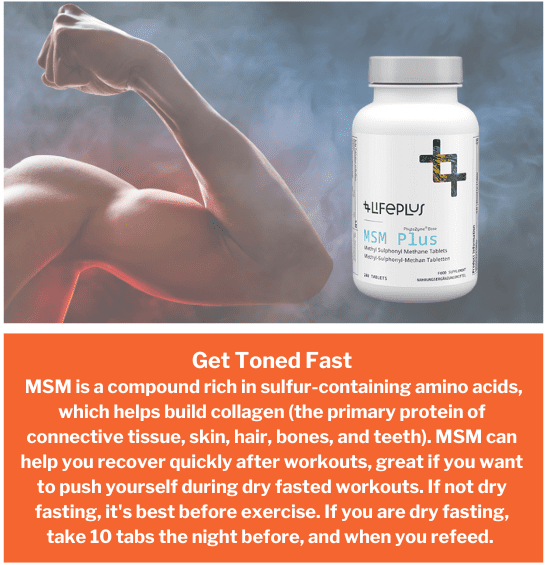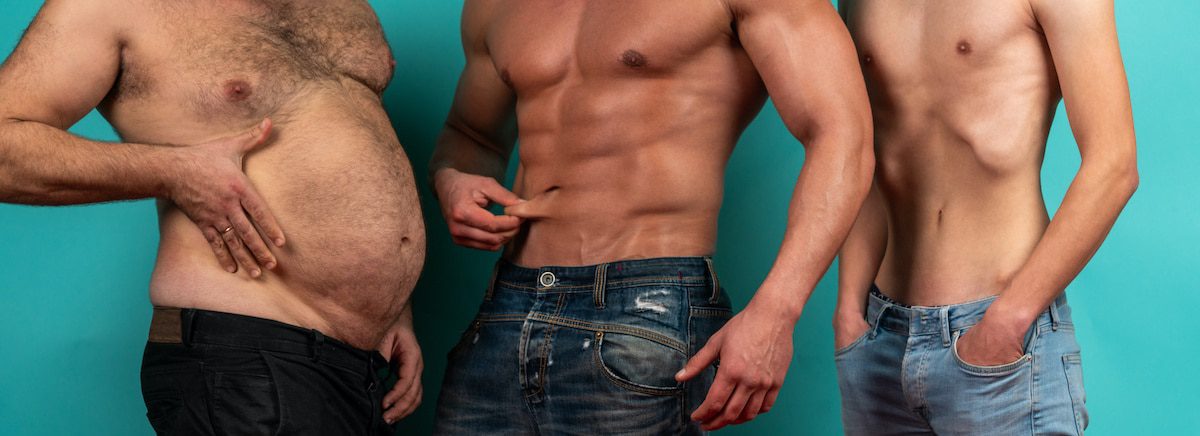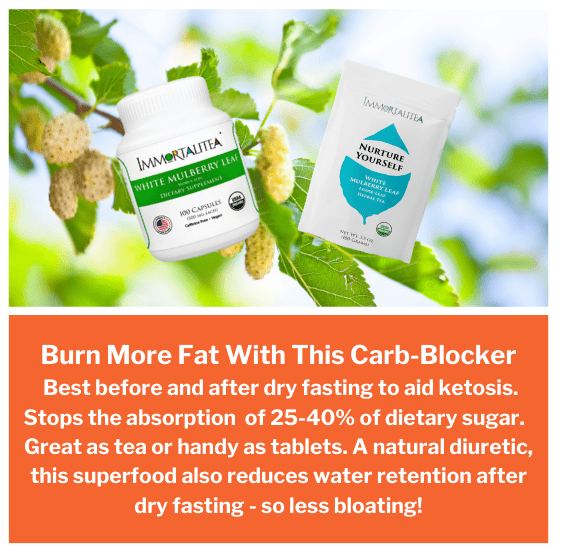You’ve just finished a dry fast. No food. No water. No exercise. Sure, there’ll be muscle loss, but it’s all worth it. Then, you do a Bioscan and realize you’ve gained muscle!
Does dry fasting cause muscle loss? Muscle loss during a dry fast is minimal as the body uses your fat stores for fuel—not your muscles. Dry fasting also increases Human Growth Hormone (HGH) secretion, which increases and preserves muscle mass.
Dieting gets a bad rep for muscle loss, but fasting and dieting are not the same things. In this article, we find out why dry fasting can be relatively muscle-friendly.
 How does dry fasting preserve muscle mass?
How does dry fasting preserve muscle mass?
Popular belief is that when your body is deprived of nutrition, it breaks down muscles into glycogen to be used as energy. When it comes to dry fasting, however, this doesn’t apply.
When you fast—intermittent fasting, prolonged water fasting, or dry fasting —your metabolism switches mode and starts tapping into its fat stores to get the energy it needs, as explained by this 1983 Cahill study on starvation.
Surprised? Here’s more.
Research conducted in 2010, over 70 days of alternate-day fasting, shows that subjects lost a significant amount of fat; however, muscle mass only dropped from 52.0 kg to 51.9kg—a meager difference.
Research by Dr.Kevin Hall, taken from this diet doctor article, indicates that even after 30 days of water fasting, the body still doesn’t eat into muscle. Protein synthesis doesn’t drop to zero, but it does fall over time.
More interesting is that ketone and fat metabolism go up, so when you are fasting, your body switches from glucose metabolism to fat metabolism.
But how does this prolonged water fasting data apply to dry fasting?
Dry fasting is water fasting on steroids, producing similar metabolic changes, but in a third of the time; therefore, the results of a 10-day dry fast are comparable to 30-day water fast.
Fasting triggers your body’s hormones to prepare for battle instead of shutting down and preserving its energy, which happens during dieting or calorie restriction.
Hormonal shifts during fasting increase your body’s metabolism, gearing up into fight or flight mode. This study shows that even after 4 days of fasting, the body uses 10% more energy than before it started.
From an evolutionary perspective, this makes sense. If a caveman went a few days without food and his body started to shut down, humanity wouldn’t have survived winter.
Your body is programmed so that even in the absence of food, you can still muster the energy to slay that woolly mammoth (or at least flee to the hills!).
Human Growth Hormone (HGH) is often acknowledged as the most muscle-friendly hormone, being described as the elixir of youth – and the reason why athletes often look a lot younger than their age.
HGH makes you stronger, more alert, and gives you a better quality of sleep. Most importantly, HGH preserves muscle mass.
This study describes how water fasting, even for 1 day, increases HGH secretion by 2-3 times (in dry fasting, hormonal secretion is triple this.)
Growth hormone continues to be doused in the body to protect muscle loss; however, although there can be some muscle growth, as described in the article, we still need the nutritional tools to rebuild muscle.
 This is where refeeding is so crucial after fasting – because that’s when you build muscle.
This is where refeeding is so crucial after fasting – because that’s when you build muscle.
If done right, you may even be able to significantly increase muscle mass, as many athletes have discovered, especially if incorporating intermittent dry fasting into your daily routine.
For more on the nitty-gritty science of muscle burning and fasting, read this article by Dr. Jason Fung, the Diet Doctor. Dr. Jason professes that he’s never had a muscle loss patient in his 5 years of treating patients for obesity and diabetes.
Will exercising during dry fasting burn muscle?
In general, you should only do light workouts – walking, yoga, and moderate resistance training—during a dry fast. Muscle loss during these exercises would be negligible.
If you manage high-intensity cardio or heavy weight lifting during a dry fast, your body will need energy quickly and won’t get that from its fat stores. (Fat is slow-burning fuel, so many people recommend taking long walks to burn fat.)
When your body suddenly needs a burst of energy (as when fleeing woolly mammoths), your body will turn to its muscular tissues for that energy, activating a process called gluconeogenesis. This is where muscles are broken down into proteins then converted into glucose as fuel for your needy cells.
So in a crazy chance that you are escaping a predator or have joined a Spartan Race, it’s likely you’ll be eating muscle for dinner.
Does limiting food intake burn muscle?
Yes and No. The complete limiting of food is not the same as partial or even minimal food limitation; in other words, dieting is not the same as fasting. During dieting, you can quickly lose muscle mass.
Calorie restriction diets where you eat 70%-50% of your nutrition allowance do not induce the same metabolic pathways activated during fasting.
This is why you won’t reap the benefits of hormonal and metabolic processes that protect muscle loss. This is also why we see many previously obese people who have lost hundreds of pounds, left with saggy, loose skin, and no muscle. For more on skin, check out my article on how dry fasting heals loose skin and increases muscle mass.
However, some fast-mimic diets, usually high-fat or keto, may be able to replicate similar pathways of fasting or dry fasting and get some of the results.
What affects muscle mass loss during a dry fast?
Body type
Your individual body type affects the rate of muscle burning and differs from person to person. An overweight person with excess fat would probably burn more fat than muscle.
This is because the body is an intelligent machine and would instead use fat in place of protein, as protein is a functional tissue that works to give us strength and makes us fit, whereas fat is simply bulk energy storage.
Studies show that during prolonged fasting (or dry fasting ), an obese person burns 2-3 times more fat than a lean person, as there’s simply more fat to burn, and the body would utilize what is more readily available.
This fasting study shows that although obese subjects have more overall protein, they lose it at a reduced rate than lean subjects.
Length of dry fast
The duration of a dry fast can impact how well you preserve muscle. When growth hormone is secreted during a dry fast, our muscles are protected; however, there is no insulin or glucose to help synthesize protein and build muscles.
So most of the muscle rebuilding actually happens at the refeeding stage, when growth hormone levels are still high, and you’ve just eaten, so your body has all the insulin, glucose, and amino acids to help rebuild muscle mass.
 Doing a dry fast for a shorter duration with more regularity would be the most beneficial method for muscle mass preservation and growth – such as an intermittent dry fast of 12-24 hours.
Doing a dry fast for a shorter duration with more regularity would be the most beneficial method for muscle mass preservation and growth – such as an intermittent dry fast of 12-24 hours.
Good options would be to dry fast for 14-16 hours daily, 18 hours three times a week, or 24 hours twice a week.
To build muscle, do your workout just before breaking your fast, and eat within 30 mins to 2 hours after for muscle gain. If you want to know more about how dry fasting can make you fitter and younger faster, check out my new video course, 25 Again! The Dry Fasting Lifestyle For A Younger, Slimmer You!
***Disclaimer: I am not a doctor/ physician, and although I have a bachelor’s degree in Biomedical Science, I cannot and do not hold myself to be a medical professional (“Medical Provider”). This article does not contain medical /health advice. The medical/ health information here is for general and educational purposes only. It is my opinion, based on my research and personal experience, and not a substitute for professional advice by your health care provider. Please consult with a professional before acting on the information here, and do not disregard medical advice or delay seeking medical attention because of anything you read in this article. THE USE OR RELIANCE OF ANY OF THE INFORMATION ON THIS WEBSITE IS SOLELY AT YOUR OWN RISK.***
References
- Dunning, August. The Phoenix Protocol Dry Fasting for Rapid Healing and Radical Life Extension: Functional Immortality. August Dunning , 2020.
- Coutinho, Luke. Dry Fasting Miracle. EBURY PR, 2020.
- Filonov, Sergey. 20 Questions & Answers About Dry Fasting . Translated by Vera Giovanna Bani , Siberika , 2019.
- Fung, Jason, and Jimmy Moore. The Complete Guide to FASTING: Heal Your Body Through Intermittent, Alternate-Day, and Extended Fasting. Victory Belt Publishing, 2016.
- Cahill GF Jr. President’s address. Starvation. Trans Am Clin Climatol Assoc. 1983;94:1-21.
- Bhutani S, Klempel MC, Berger RA, Varady KA. Improvements in coronary heart disease risk indicators by alternate-day fasting involve adipose tissue modulations. Obesity (Silver Spring). 2010;18(11):2152-2159. doi:10.1038/oby.2010.54
- https://www.dietdoctor.com/fasting-muscle-mass
- https://www.dietdoctor.com/does-fasting-burn-muscle
- Zauner C, Schneeweiss B, Kranz A, et al. Resting energy expenditure in short-term starvation is increased as a result of an increase in serum norepinephrine. Am J Clin Nutr. 2000;71(6):1511-1515. doi:10.1093/ajcn/71.6.1511
- Elia M, Stubbs RJ, Henry CJ. Differences in fat, carbohydrate, and protein metabolism between lean and obese subjects undergoing total starvation. Obes Res. 1999;7(6):597-604. doi:10.1002/j.1550-8528.1999.tb00720.x






